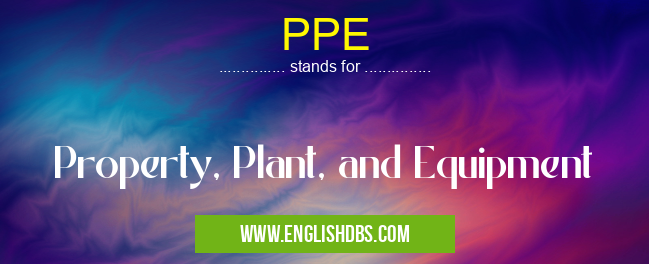What does PPE mean in ACCOUNTING
Property, Plant, and Equipment (PPE) are tangible assets that provide long-term value to a business. Generally, these assets are classified as non-current assets because they are not expected to be used up or converted into cash within the accounting year. PPE items have a useful life of more than one year and usually include land, buildings, vehicles, furniture, fixtures, equipment, tools, and improvements to property. It is important to note that PPE may be depreciated over time if the company chooses to do so. In this article we will look at what PPE means in business and the full form of it.

PPE meaning in Accounting in Business
PPE mostly used in an acronym Accounting in Category Business that means Property, Plant, and Equipment
Shorthand: PPE,
Full Form: Property, Plant, and Equipment
For more information of "Property, Plant, and Equipment", see the section below.
» Business » Accounting
Definition
PPE stands for Property, Plant, and Equipment. These are physical non-current assets that can be held for use in the company's operations or for investment purposes. Examples of PPE items include buildings (e.g., office space), vehicles (e.g., delivery vans), furniture (e.g., chairs and desks), machinery (e.g., manufacturing equipment), tools (e.g., saws) and other physical assets that are used in production or service activities by the company on an ongoing basis such as leasehold improvements for a retail store or post construction repair work for an office building.
Purpose
The purpose of keeping track of these assets is to ensure accurate financial reporting since they require specialized accounting treatments due to their long-term usage within a company’s operations/activities or investments held by it over several years.
Capitalization Criteria
The capitalization criteria used by businesses when identifying PPE depend on their industry/sector and types of products/services offered but generally some important criteria include cost of purchase/construction/leasehold improvement needs to exceed certain monetary threshold set by companies themselves.
How Do Changes In The Value Of Property Plant & Equipment Affect A Business?
Changes in the value of property plant & equipment affect a business both positively and negatively depending on whether it results from devaluation due to obsolescence or arises from appreciation due to improved market value or enhanced performance potentials.
Essential Questions and Answers on Property, Plant, and Equipment in "BUSINESS»ACCOUNTING"
What is PPE?
Property, Plant, and Equipment (PPE) is an accounting term that refers to tangible assets acquired to use in the production or supply of goods and services. PPE typically includes items such as land, buildings, machinery, computers, furniture, vehicles and other equipment used by a business to generate income.
How are PPE assets accounted for?
Property, Plant and Equipment are initially recorded at the cost of purchase. This includes any applicable taxes and freight charges associated with the acquisition of the asset. Thereafter depreciation needs to be applied on all such property over their useful lives until the fixed asset is fully depreciated with respect to its cost.
Are improvements included in PPE?
Yes, improvements made to property that increase its life expectancy or value can be included as part of Property, Plant & Equipment. These include renovations that extend the life of a building or repairs that replace old parts with new ones.
Do I need to write-off any portion of my PPE investments?
If these investments become obsolete due to changing technology or environmental factors then they must be written-off from your accounting records as an expense immediately. This is done so you may reflect their true economic value in your financial statements.
What are some examples of Property, Plant & Equipment?
Some common examples of Property Plant & Equipment include items like office furniture & fixtures, computers & IT equipment buildings/land for manufacturing processes or storage purposes, vehicles used for transport purposes and machinery used in production processes.
Is it possible to finance acquiring Property Plant & Equipment?
Yes it's possible to finance acquiring Property Plant & Equipment either through a loan from a financial institution or through equity financing from outside sources e.g venture capitalists etc. The advantage this provides is that it spreads out the costs incurred over time thus reducing the financial burden on your business more easily compared to outright payment upfront.
How do you calculate depreciation on PPE assets?
Depreciation on these assets should be calculated based on their estimated useful life which could vary depending upon various factors such as usage intensity etc. A commonly used method is straight-line depreciation where periodic amounts equal each year over the entire useful life period however there are other methods available too - all advised by professional accountants prior to implementation for accuracy purposes depending upon each entity’s specific circumstances theretofore.
